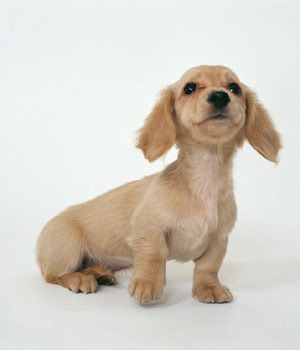Breed Info - Dachshund
Overview
|
Breed Group
Hound Size Small How much exercise? Up to 30 minutes per day Length of coat Short How much grooming? Once a week |
Sheds?
Yes Town or Country Either Type of home Apartment Minimum Garden Size None Lifespan Over 12 Years |
Description
Spunky, curious, friendly
Spunky, curious, friendly
The origins of the Dachshund can be traced back to working dogs that could go to ground after game such as badgers and rabbits, or to track fallen/wounded deer. Today, Dachshunds are very popular as intelligent and faithful pets, both for town and country dwellers.
In the UK, the Dachshund comes in six varieties, two sizes – Standards weighing up to 12 kg (26 lbs) and Miniatures ideally weighing 4.5 kg (10 lbs) and no more than 5 kg (11 lbs) - and three coats – Smooth-haired, Long-haired & Wire-haired. Germany is the breed’s home country where sizes are separated not by weight but by chest circumference, with three sizes being based on what size of hole they could enter when going to ground. All in all, a marvellous selection of attractive and sporting dogs.
Dachshunds are active dogs and, once fully mature, will take as much exercise as you can give them and you are likely to want to go home before they do. They are, however, just as happy curled up on your lap, snoozing. They are loyal companions and generally make good family pets. They are not noted for their obedience but, with patience and persistence by the owner, they can be trained. However, they are Hounds and when they are off the lead, if they get a scent, they can “go deaf” when it suits them.
Temperamentally all six varieties are very good at giving a good account of themselves and, as such, are excellent house-dogs who will guard your property from any unwelcome guests. His bark can be deep, especially in the Standards, and people are often surprised to hear such a deep noise coming from a dog the size of a Dachshund.
The breed is characterised as moderately long and low with no exaggerations, and should have a well-muscled body with enough ground clearance to allow free movement. The front feet are used for digging and should be big, broad and well-arched, point forward, or only slightly turned outwards. As befits his working origins, the Dachshund should have strong teeth and a powerful jaw.
The Dachshund is a short-legged dog, not a long-backed one. Excessive length can lead to problems with back disease. It is important that the ribbing should extend well back and the loin should be short and strong
The Miniature-Smooth variety should have dense, short coats that require very little grooming other than a “quick shine” with a brush once a week. The most common colours are Black and Tan, Red (ranging from Clear Red to Shaded Red) and Chocolate and Tan. As a generalisation, the Min-Smooths have outgoing temperaments and make ideal pets for someone who is fairly active and who wants a small but affectionate companion.
In the UK, the Dachshund comes in six varieties, two sizes – Standards weighing up to 12 kg (26 lbs) and Miniatures ideally weighing 4.5 kg (10 lbs) and no more than 5 kg (11 lbs) - and three coats – Smooth-haired, Long-haired & Wire-haired. Germany is the breed’s home country where sizes are separated not by weight but by chest circumference, with three sizes being based on what size of hole they could enter when going to ground. All in all, a marvellous selection of attractive and sporting dogs.
Dachshunds are active dogs and, once fully mature, will take as much exercise as you can give them and you are likely to want to go home before they do. They are, however, just as happy curled up on your lap, snoozing. They are loyal companions and generally make good family pets. They are not noted for their obedience but, with patience and persistence by the owner, they can be trained. However, they are Hounds and when they are off the lead, if they get a scent, they can “go deaf” when it suits them.
Temperamentally all six varieties are very good at giving a good account of themselves and, as such, are excellent house-dogs who will guard your property from any unwelcome guests. His bark can be deep, especially in the Standards, and people are often surprised to hear such a deep noise coming from a dog the size of a Dachshund.
The breed is characterised as moderately long and low with no exaggerations, and should have a well-muscled body with enough ground clearance to allow free movement. The front feet are used for digging and should be big, broad and well-arched, point forward, or only slightly turned outwards. As befits his working origins, the Dachshund should have strong teeth and a powerful jaw.
The Dachshund is a short-legged dog, not a long-backed one. Excessive length can lead to problems with back disease. It is important that the ribbing should extend well back and the loin should be short and strong
The Miniature-Smooth variety should have dense, short coats that require very little grooming other than a “quick shine” with a brush once a week. The most common colours are Black and Tan, Red (ranging from Clear Red to Shaded Red) and Chocolate and Tan. As a generalisation, the Min-Smooths have outgoing temperaments and make ideal pets for someone who is fairly active and who wants a small but affectionate companion.
| |||


